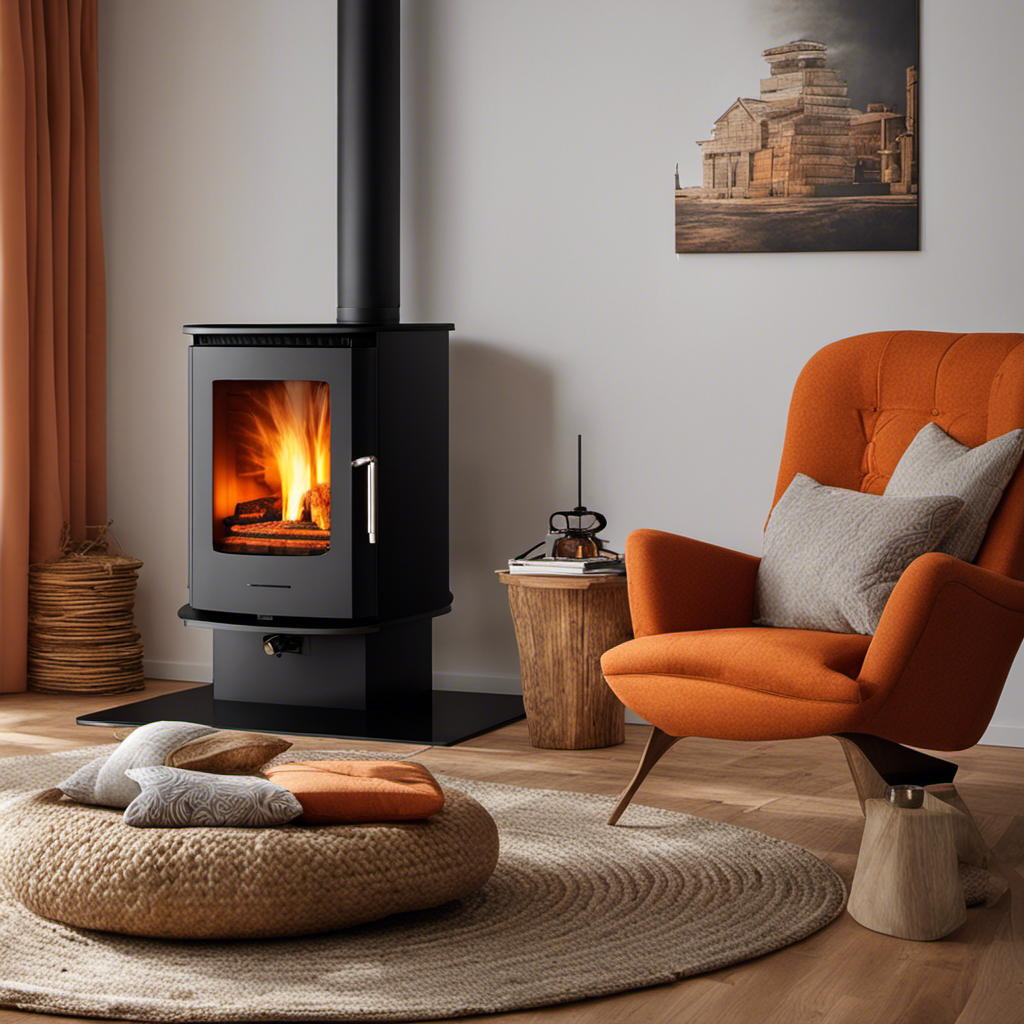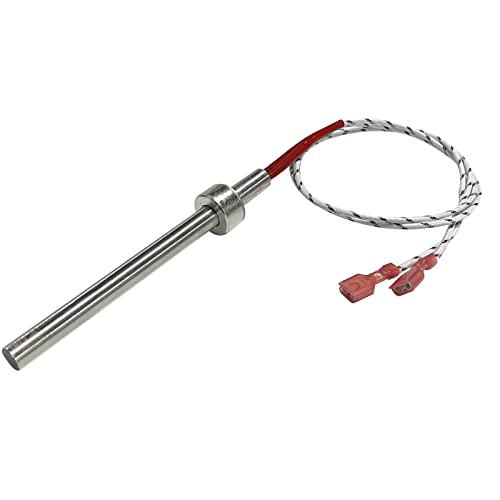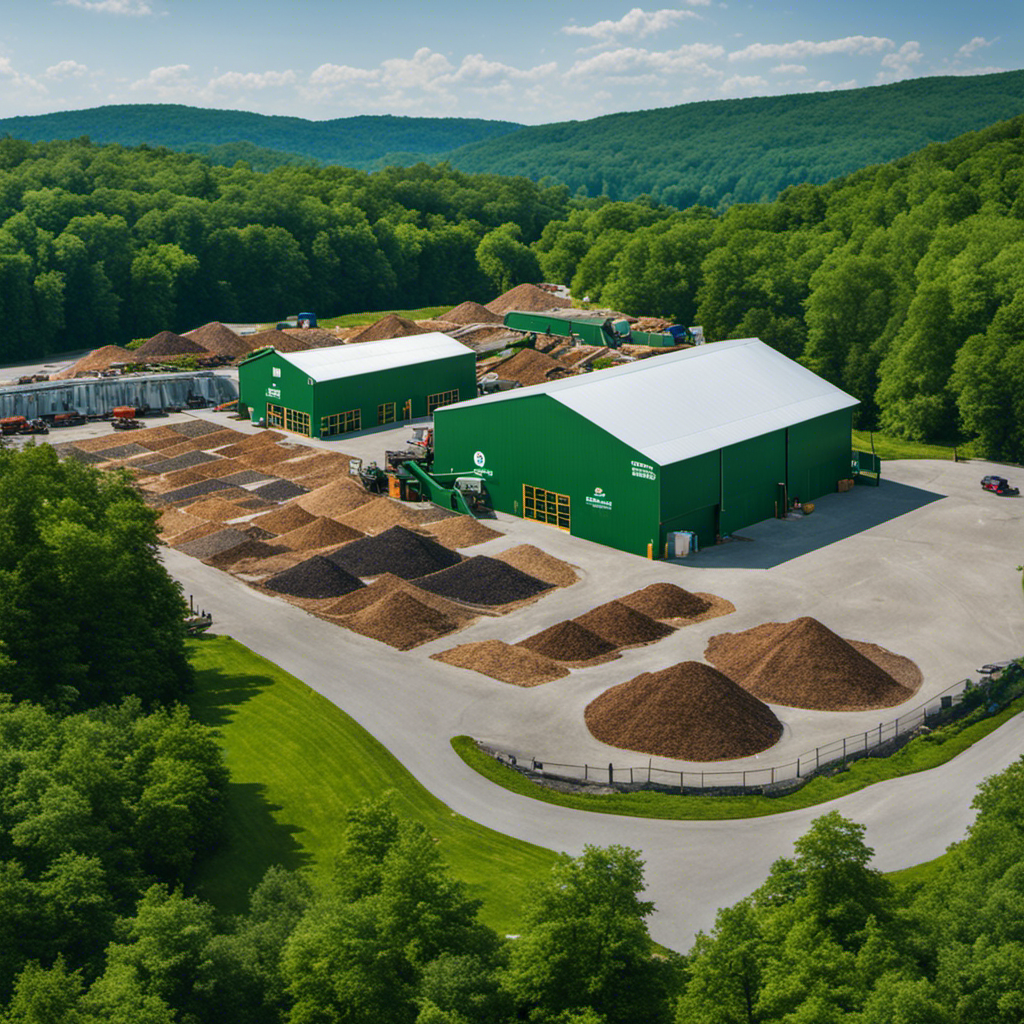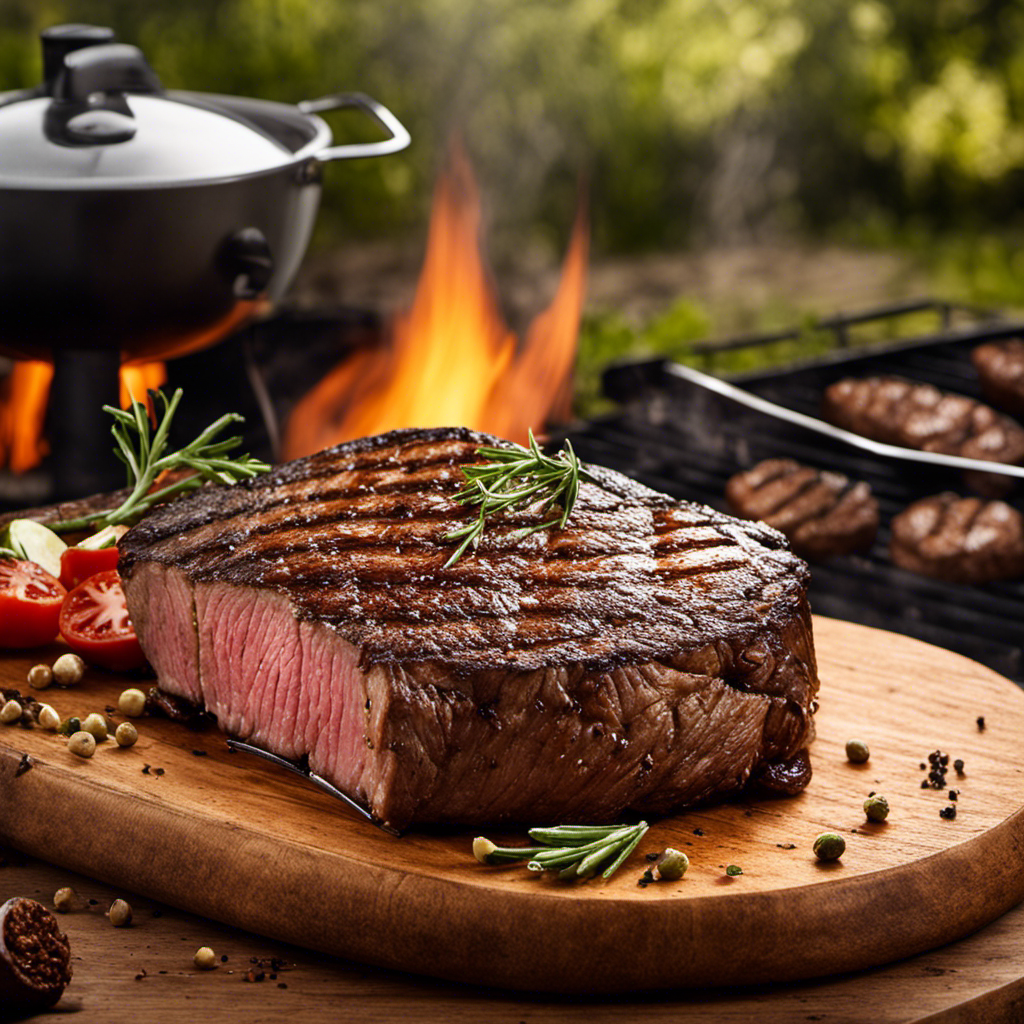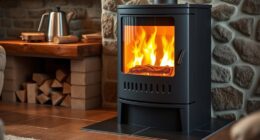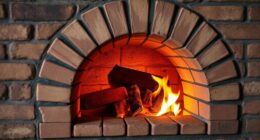Many of us have heard the excitement surrounding pellet stoves, renowned for their efficiency and environmental advantages, sparking our interest. Yet, one may question, do these impressive heating devices truly meet their acclaimed reputation?
In this article, we’ll dive into the inner workings of pellet stoves, exploring how they operate and the advantages they offer. We’ll also shed light on the environmental impact of using pellets as fuel, and weigh the pros and cons.
Get ready to uncover the truth and gain an informed perspective on the future of sustainable heating.
Key Takeaways
- Pellet stoves use a fan to force air over hot coals and have a closed-combustion system, making them highly efficient in heating the room.
- Pellet stoves are more efficient than traditional wood-burning fireplaces and can reduce heat loss up the chimney by up to 60%.
- Pellet fuel is made from renewable sources and often from recycled materials, making it environmentally friendly and reducing waste.
- While manufacturing and transportation of pellets may have some negative environmental impact, overall, pellet stoves are a sustainable and cleaner option compared to many other heating options.
How Pellet Stoves Work
We have learned that pellet stoves use a fan to force air over hot coals and that pellets are fed into the stove by an auger. These stoves offer efficiency benefits that make them a popular choice for heating homes.
The heat produced by burning pellets is used to warm the room, and pellet stoves have a closed-combustion system, minimizing heat loss up the chimney. This means that they’re highly efficient in heating the room, reducing energy consumption and costs.
However, it’s important to note that pellet stoves require regular maintenance to ensure optimal performance. This includes cleaning the stove, inspecting and replacing any worn parts, and regularly removing ash buildup.
The Benefits of Pellet Stoves
Our research shows that using pellet stoves can have numerous advantages, such as reducing heat loss and emitting fewer greenhouse gases compared to other heating options.
- Pellet fuel is made from renewable sources such as wood waste and biomass materials.
- Pellet stoves are more efficient than traditional wood-burning fireplaces.
- They can reduce heat loss up the chimney by up to 60%.
- Pellet stoves emit fewer greenhouse gases and produce less pollution than oil or gas furnaces.
- Pellets for pellet stoves are made from renewable materials like wood.
Not only are pellet stoves a renewable energy option, but they also offer cost efficiency. The pellets used are often made from recycled materials, reducing waste and conserving resources. Additionally, pellets are compressed, which reduces transport and storage costs.
With their high efficiency and reduced environmental impact, pellet stoves are a sustainable and economical choice compared to other heating options.
The Environmental Impact of Pellets
When considering the environmental impact of pellets, it’s important to evaluate the manufacturing and transportation processes.
The manufacturing process of pellets involves using renewable materials like wood waste and sawdust, which are compressed to form the pellets. This process requires energy and resources, but it also reduces waste and conserves resources by using recycled materials.
However, transportation of the pellets may involve the use of fossil fuels, which can contribute to carbon emissions. It’s crucial to consider the carbon footprint of transporting the pellets to determine their overall environmental impact.
Stricter regulations on moisture and ash content help minimize emissions when burning the pellets. While pellet stoves have some environmental drawbacks, they’re generally considered cleaner than many other heating options.
The Pros of Pellet Stoves
Compressed pellets made from renewable materials like wood are an environmentally friendly and sustainable option for heating. When it comes to pellet stoves, there are several advantages that make them a popular choice. Here are five key benefits:
-
Cost efficiency: Pellet stoves are highly efficient in heating the room, which helps in reducing heating costs.
-
Low maintenance: Pellet stoves require minimal maintenance compared to traditional wood-burning fireplaces.
-
Clean and eco-friendly: Pellet stoves emit fewer greenhouse gases and produce less pollution than oil or gas furnaces.
-
Renewable fuel source: Pellet fuel is made from renewable sources like wood waste and biomass materials, making it a sustainable option.
-
Reduced storage and transportation costs: Pellets are compressed, reducing the need for large storage spaces and making transportation more efficient.
Overall, pellet stoves offer a cost-effective and environmentally friendly heating solution, requiring less maintenance and utilizing renewable resources.
The Cons of Pellet Stoves
While there are many advantages to using pellet stoves, it’s important to consider the potential drawbacks as well.
One of the concerns is the carbon footprint associated with the manufacturing and transportation of pellets. Although pellets are made from renewable materials like wood waste and sawdust, the process still requires energy and resources.
Additionally, the transportation of pellets may involve the use of fossil fuels, which can contribute to greenhouse gas emissions.
Another factor to consider is the energy efficiency of pellet stoves. While they’re more efficient than traditional wood-burning fireplaces, burning pellets may still release some emissions, albeit at lower levels than other stoves. Stricter regulations on moisture and ash content help minimize emissions, but it’s important to weigh the overall environmental impact of pellet stoves against their benefits.
Efficiency and Heat Loss in Pellet Stoves
Another factor to consider is that pellet stoves are highly efficient in heating the room, minimizing heat loss up the chimney. This means that more of the heat produced by burning pellets is distributed evenly throughout the space, resulting in a more comfortable and cozy environment.
When it comes to heat distribution and energy efficiency, pellet stoves have several advantages:
-
Pellet stoves use a fan to force air over hot coals, ensuring that the heat is evenly distributed.
-
The closed-combustion system of pellet stoves minimizes heat loss up the chimney, maximizing energy efficiency.
-
Pellet stoves can reduce heat loss up the chimney by up to 60%, making them more efficient than traditional wood-burning fireplaces.
-
By burning pellets made from renewable sources like wood waste and biomass materials, pellet stoves are an environmentally friendly heating option.
-
Pellet stoves emit fewer greenhouse gases and produce less pollution than oil or gas furnaces, making them a cleaner choice for heat distribution.
Pellet Fuel: Renewable and Sustainable
When it comes to renewable and sustainable heating options, we’re pleased to find that pellet fuel is made from renewable sources such as wood waste and biomass materials.
Pellet fuel sustainability is a key factor in its appeal. Unlike fossil fuels, which are finite resources, pellet fuel can be continuously produced from renewable energy sources. This means that as long as there’s a supply of wood waste or biomass materials, pellet fuel can be created.
These renewable energy sources for pellet fuel help reduce our reliance on non-renewable resources and contribute to a greener future. Additionally, pellet fuel can also be made from recycled materials like wood products or paper mill waste, further reducing waste and conserving resources.
Overall, pellet fuel is a sustainable and environmentally friendly option for heating.
Manufacturing and Transportation of Pellets
In terms of the manufacturing and transportation of pellets, we must consider their potential negative impact on the environment.
Manufacturing challenges: The production of pellets requires energy and resources, which can contribute to environmental issues such as air and water pollution.
Environmental certifications: It’s important for pellet manufacturers to obtain environmental certifications to ensure sustainable practices and minimize their ecological footprint.
Sustainable sourcing: Pellets made from renewable materials like wood waste and sawdust are more environmentally friendly.
Transportation emissions: The transportation of pellets may involve the use of fossil fuels, which can contribute to greenhouse gas emissions.
Overall impact: The environmental impact of pellets depends on the manufacturing and transportation processes, as well as the use of renewable and recycled materials. It’s crucial to prioritize sustainable practices and certifications to mitigate any negative effects on the environment.
Emissions and Pollution From Pellet Stoves
Now let’s delve into the emissions and pollution that can arise from pellet stoves. While pellet stoves are generally considered cleaner than other heating options, they do emit some pollutants during operation. These emissions can have both environmental and health effects.
To provide a comprehensive understanding, let’s examine the emissions reduction strategies and the potential health effects of pellet stove emissions in the table below:
| Emissions Reduction Strategies | Health Effects of Pellet Stove Emissions |
|---|---|
| Regular maintenance and cleaning of the stove to ensure efficient combustion. | Fine particulate matter (PM2.5) emissions from pellet stoves can have adverse health effects, particularly on respiratory health. |
| Using properly seasoned pellets with low moisture content to minimize emissions. | Carbon monoxide (CO) emissions can be a concern if the stove is not properly vented or operated in poorly ventilated areas. |
| Employing advanced combustion technologies that optimize fuel combustion and reduce emissions. | Limited studies suggest that exposure to pellet stove emissions may increase the risk of cardiovascular disease and lung cancer. However, more research is needed to fully understand the health impacts. |
| Installing and maintaining appropriate ventilation systems to ensure the proper removal of emissions from the living space. | The emissions from pellet stoves can contribute to outdoor air pollution, especially in areas with high concentrations of pellet stove usage. |
| Encouraging the use of certified pellet stoves that meet strict emissions standards for cleaner and more efficient operation. | Children, the elderly, and individuals with pre-existing respiratory conditions are particularly susceptible to the health effects of pellet stove emissions. |
It is important to note that while pellet stoves emit pollutants, their emissions can be significantly reduced with proper maintenance, fuel selection, and ventilation practices. Additionally, the health effects of pellet stove emissions need further investigation to determine the full extent of their impact on human health.
Regulations and Standards for Pellet Stoves
One important aspect to consider is the role of regulations and standards in ensuring the efficiency and environmental friendliness of pellet stoves.
-
Regulations implementation: The implementation of regulations ensures that pellet stoves meet specific standards, including emission limits and efficiency requirements.
-
Impact on air quality: By enforcing regulations, pellet stoves can significantly reduce air pollution and improve air quality in both indoor and outdoor environments.
-
Efficiency improvement: Regulations push manufacturers to develop more efficient pellet stoves, which results in lower fuel consumption and reduced greenhouse gas emissions.
-
Emission control: Standards for pellet stoves help control the release of harmful pollutants, such as particulate matter and volatile organic compounds, which can have adverse health effects.
-
Compliance monitoring: Regulations also require regular testing and monitoring of pellet stoves to ensure ongoing compliance, further ensuring their efficiency and environmental friendliness.
Comparing Pellet Stoves to Other Heating Options
When comparing heating options, we find that pellet stoves are a more efficient and environmentally friendly choice.
Pellet stoves are highly efficient in heating a room, reducing heat loss up the chimney by up to 60%. In comparison, electric heaters can be expensive to run and may struggle to effectively heat larger spaces.
Additionally, pellet stoves are cost-effective compared to gas furnaces. Pellet fuel is made from renewable sources, such as wood waste, and can even be made from recycled materials, reducing waste and conserving resources.
While the manufacturing and transportation of pellets may have some environmental impact, overall, pellet stoves emit fewer greenhouse gases and produce less pollution than oil or gas furnaces.
Therefore, when considering both efficiency and environmental impact, pellet stoves are a favorable option.
Are Pellet Stoves Safe for Heating If They Aren’t Suitable for Cooking?
Pellet stoves are safe for heating, but they fall short when it comes to cooking. The design and function of pellet stoves make them ideal for heating homes, but they lack the necessary features for cooking. This is why pellet stoves fall short in the kitchen.
Are Pellet Stoves Safe for Heating if They Fall Short for Cooking?
While pellet stoves are effective for heating, they may not be ideal for cooking. One of the reasons pellet stoves aren’t ideal for cooking is that they may not reach high enough temperatures for certain dishes. Additionally, the potential for carbon monoxide emissions poses safety concerns for indoor cooking.
Frequently Asked Questions
Are Pellet Stoves More Efficient Than Traditional Wood-Burning Fireplaces?
Pellet stoves are more efficient than traditional wood-burning fireplaces. They use a closed-combustion system and a fan to force air over hot coals, maximizing heat output. This means that more heat is generated from burning pellets, resulting in greater cost effectiveness compared to wood-burning fireplaces.
Additionally, pellet stoves are more convenient and easier to use, as they can be easily controlled and require less maintenance than traditional fireplaces.
Overall, pellet stoves offer a more efficient and user-friendly heating option.
How Do Pellet Stoves Compare to Oil or Gas Furnaces in Terms of Emissions and Pollution?
When comparing emissions and pollution, pellet stoves are a cleaner option compared to oil or gas furnaces. Pellet stoves emit fewer greenhouse gases and produce less pollution.
In terms of efficiency, pellet stoves outperform traditional wood-burning fireplaces. They reduce heat loss up the chimney by up to 60%.
While manufacturing and transportation of pellets may have some negative environmental impact, overall, pellet stoves are a sustainable and environmentally friendly heating option.
What Are the Regulations and Standards for Pellet Stoves, Particularly Regarding Moisture and Ash Content?
Regulations and standards play a crucial role in ensuring the efficiency and environmental impact of pellet stoves. Regarding moisture and ash content, stricter regulations are in place to minimize emissions.
Pellet stoves are more efficient than traditional wood-burning fireplaces and emit fewer greenhouse gases. However, manufacturing pellets requires energy and resources, and transportation may involve the use of fossil fuels.
Despite these drawbacks, pellet stoves are considered a sustainable option compared to other stoves due to their renewable fuel source and reduced pollution levels.
How Do Pellet Stoves Compare to Other Heating Options in Terms of Sustainability and Environmental Impact?
In terms of sustainability and environmental impact, pellet stoves offer a compelling solution. One interesting statistic is that pellet stoves can reduce heat loss up the chimney by up to 60%. This means that they’re more efficient than traditional wood-burning fireplaces and contribute to a significant reduction in carbon emissions.
Additionally, pellet fuel is made from renewable sources like wood waste and biomass materials, further reducing their carbon footprint.
Overall, pellet stoves provide a sustainable and environmentally friendly heating option.
What Are the Energy and Resource Requirements for Manufacturing Pellets?
In terms of energy efficiency and environmental impact, the manufacturing of pellets requires energy and resources. The process typically involves compressing renewable materials like wood waste and sawdust, which helps reduce transport and storage costs.
However, transportation may still involve the use of fossil fuels. It’s important to note that stricter regulations on moisture and ash content have been put in place to minimize emissions during the burning of pellets.
Overall, the energy and resource requirements for manufacturing pellets should be considered in assessing their sustainability.
Conclusion
In conclusion, while pellet stoves offer efficient heating and environmental benefits, it’s important to consider the potential negative impacts associated with their manufacturing and transportation processes.
While they’re sustainable and renewable, emissions and pollution from pellet stoves should also be taken into account.
By comparing pellet stoves to other heating options and examining regulations and standards, we can make informed decisions about their role in a sustainable and efficient heating future.

